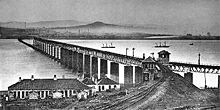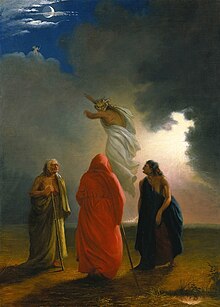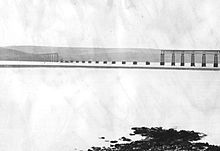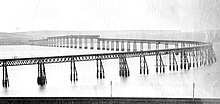The bridge on the Tay

Die Brück 'am Tay is a ballad by Theodor Fontane . It is about the collapse of the Firth of Tay Bridge in Scotland on December 28, 1879, which killed 75 people on a train. The Firth of Tay Bridge was built between 1871 and 1878 at enormous expense and collapsed in a storm a year and a half after it was opened. Fontane, who had toured Scotland, frames the depiction of the misfortune with the motif of the witches from Shakespeare's Macbeth and thus makes his ballad a reminder of tech-savvy hubris . He puts his conclusion in the mouth of one of the witches:
" Trinkets , trinkets / Is the creation of human hands."
Work history
Fontane wrote the ballad "in the first days of January [...] in the wake of the terrible railway accident in Scotland" so that they "a week later", on 10 January 1880 in Issue 2 of the journal The presence could appear . On January 15, 1880, Fontane wrote in a letter to his trusted correspondent Mathilde von Rohr :
“Last week in No. 2 published a poem of the 'present': 'The Bridge' on the Tay ', in which I treated the terrible railway accident at Dundee in a ballad-like manner. […] It caused a kind of sensation here, maybe more than anything I've written. Kahle will perform it for 14 days on Sunday in a Singakademie concert. "
Fontane's source were reports of the accident that appeared in the Vossische Zeitung from December 29, 1879 .
content
Three witches make an appointment to collapse the bridge with the train driving over it. The actual misfortune is depicted from the perspective of the "Brückner people" and their son Johnie, who is on the train. The witches arrange the next meeting and are satisfied with their work of destruction.

The ballad begins with the three witches from Shakespeare's Macbeth:
"When will the three of us meet again?"
- "At the seventh hour on the Brückendamm."
- "On the central pillar."
- "I put out the flame."
- "Me with."
- "I come from the north."
- "And I from the south."
- "And I from the sea."
"Hey, that's a row of rings,
and the bridge has to go into the bottom."
- “And the train entering the bridge
At the seventh hour? "
- "Hey, he has to go with"
"Must go."
- “Trifles, trinkets
Is the structure made by human hands! "
The preceding motto When shall we three meet again | M acbeth makes the reference to this drama, the first scene of which is varied in the first verse of the ballad. The witches, described by Shakespeare's Macbeth as rulers of elementary forces that destroy civilization, should be understood as personified forces of nature that will once again destroy the work of man.
The bridge keeper couple anxiously awaits the train from Edinburgh and their son Johnie, who wants to visit them today, three days after Christmas.
And the Brücknersleut, without rest and rest,
and look to the south in fear,
seeing and waiting, whether there is not a light,
Across the water “I'm coming” speaks,
“I'm coming, despite the night and stormy flight,
I , the Edinburgh train.
Johnie also shares the confidence that he can master everything with modern technology:
And Johnie says: “The bridge still!
But what does it do, we force it.
A solid kettle, a double steam, they
remain victorious in such a fight,
And
no matter how it races and wrestles and runs, we get it under: the element. "
Proud of the superiority of modern technology, he thinks of the inconveniences of the time before the bridge was built:
And our pride is our bridge;
I laugh, I think back to earlier,
All the misery and all the misery
With the wretched old boat;
But Johnie's parents watch as the train finally crashes into the sea:
Because the game of the winds became angrier,
And now, as if fire fell from the sky, It
glows in splendor
shooting down over the water ... And again it is night.
This ends the description of the accident. Fontane could not have known much more when the poem was written at the beginning of January. Even the witches, who will now have their say, will only be able to communicate details such as the number and names of the victims and their fates at their next meeting.
"When will the three of us meet again?"
- "At midnight, on the mountain ridge."
- "On the high moor, on the alder trunk."
- "I'm coming."
- "Me with."
- "I'll tell you the number."
- "And me the names."
- "And I am tortured."
"Hey!
The framework broke in two like splinters. "
- “Trifles, trinkets
Is the structure made by human hands! "
Design of the poem
The ballad consists of seven stanzas , the middle five of which each contain eight Knittel verses . The two frame stanzas are also visually striking because - following the exchange of words in the witch's dialogue - a verse is split into two or, in the last stanza, even over three lines. The first stanza consists of eleven, the last, a shortened variation of the first, of nine verses, whereby the first and last lines of the stanzas are identical.
Of the deputy to end at the meter verses "Hey!" And "Trinkets, trinkets ..." the last stanza apart, the verses have four elevations with free filling by unstressed syllables. In the first verse, the lowering is suppressed by a syncope after "three" , so that two stressed syllables meet directly. The penultimate verse of the 1st stanza "Must with ... trinkets, trinkets" even consists only of elevations due to syncopation. According to the Knittel verse, the end rhyme is a pair rhyme . The loose form of the Knittel verse is particularly suitable for narrative poems and has therefore been common since the Middle Ages , especially for folk poems or poems that imitate the folk tone of voice. In contrast to the looseness of the meter stands the rigor of the cadence formation . Each verse ends masculine, that is, with a stressed syllable. This means that around half of the German words are excluded from the design of the mailing. Fontane brings the verse into a balance of looseness and rigor in terms of meter and cadence. This is characteristic of the art ballad and distinguishes it from the folk ballad , which has no strictness in the formal design.
The five internal stanzas, which tell the minutes before the accident from different perspectives, again consist of a frame around the middle three stanzas, which largely reproduce the observations and thoughts of the train driver and his waiting parents in the bridge house in verbatim speech. The wording of the first half of the 2nd and 6th stanzas, which form the inner frame, is identical, the second half with the signal words storm and night varies and intensifies. Many other motifs are also taken up and varied (light, Christmas, water). This variation principle corresponds to the above mentioned metric balance.
A ballad usually contains features of the three literary genres, which it does here as well. As a narrative poem, it makes use of the design features of lyric (verse, meter, rhyme) and epic (depicting the course of the plot). Verbatim speech is the defining feature of drama . She dominates the poem with a share of more than two thirds.
Fontane gives the already sufficiently spectacular disaster an additional eerie component through the witch's dialogue in the framework stanzas: By not assigning the individual sentences to the participants, he suggests a tangle of voices of rationally inconceivable powers that destroy the rationality of human engineering. The intertextual Macbeth quote uses its implications (the witches are an expression of Macbeth's remorse and psychological pressure) for the conservative-skeptical message of the sixty-year-old poet: The hubris of the technical world calls for a corrective.
reception
Today the poem is a classic in German lessons at school. The band Junge Dichter und Denker processed the ballad into a contemporary R&B song.
text
- Theodor Fontane: The bridge on the Tay. (December 28, 1879). In: Ders .: Poems I. 2. durchges. u. exp. Edition. 1995, pp. 153–155 (Grosse Brandenburger Edition).
literature
Primary texts:
- Theodor Fontane: The bridge on the Tay. December 28, 1879. In: The Present. Weekly for literature, art and public life, ed. by Paul Lindau, Volume XVII, No. 2, January 10, 1880, pp. 20f. [First print]
-
Wikimedia Commons :
- Facsimile of the first printing. In: The Present (p. 1)
- Reports of the accident. In: Vossische Zeitung (pp. 2–5)
- Theodor Fontane: The bridge on the Tay. December 28, 1879. In: Poems. 5th increased edition. Hertz, Berlin 1898, pp. 202–204 [last edition].
Research literature:
- Andreas Beck: Build up, build up! Poetic engineering in Theodor Fontane's' Brück 'am Tay'. In: Angermion , 7, 2014, pp. 125–155, full text
- Kurt Groom: Theodor Fontane: 'The Bridge on the Tay'. In: Kurt Bräutigam (Ed.): The German Ballade. Ways to interpret them at the intermediate level. 5th edition. Diesterweg, Frankfurt am Main 1971 [first 1962], pp. 108-116.
- Gilbert Carr: Derailment and Deconstruction. Theodor Fontanes' Die Brück 'am Tay'. In: Jürgen Barkhoff, Gilbert Carr, Roger Paulin (eds.): The difficult nineteenth century. Germanistic conference on the 65th birthday of Eda Sagarra in August 1998. Niemeyer, Tübingen 2000, pp. 319–333.
- Theo Elm: Old ballad tone and new fabric world. Theodor Fontane: 'The Bridge on the Tay'. In: Helmut Scheuer (Ed.): Interpretations. Poems by Theodor Fontane. Reclam, Stuttgart 2001 (RUB 17515), pp. 154-163.
- Philipp Frank: Theodor Fontane and technology. Königshausen & Neumann, Würzburg 2005 (Epistemata. Würzburg Scientific Writings. Series Literary Studies 526).
- Philip Grundlehner: The Lyrical Bridge. Essays from Hölderlin to Benn, Rutherford, Madison, Teaneck. Associated University Press, London 1979. pp. 81 ff. Books.google
- Alfred Ch. Heinimann: Technical innovation and literary appropriation. The railroad in 19th century German and English literature. Francke, Bern 1992 (Basel Studies on German Language and Literature 63).
- Ulrich Kittstein: "The framework broke in two like splinters". The Tay disaster of 1879 in contemporary German ballad poetry. In: Fontane Blätter 81 (2006), pp. 34–45.
- Hartmut Laufhütte : Modern technology in 19th century ballads. In: Winfried Woesler (Ed.): Ballad and Historicism. The historical ballad of the 19th century. Winter, Heidelberg 2000 (Supplements to Euphorion 38), pp. 135–155.
- Johannes Mahr: Railways in German poetry. The change of a literary motif in the 19th and early 20th centuries. Fink, Munich 1982.
- Fritz Martini: Theodor Fontane. The bridge on the Tay. In: Rupert Hirschenauer, Albrecht Weber (ed.): Paths to the poem. II. Interpretation of ballads. Schnell and Steiner, Munich and Zurich 1976, pp. 377–392.
- Harro Segeberg: Literary technology pictures. Studies on the relationship between the history of technology and literature in the 19th and early 20th centuries. Niemeyer, Tübingen 1987 (studies and texts on the social history of literature 17). P. 122 ff. Books.google
media
- Knights and ravens (ballads); Otto Sander and the Oakmusic Ensemble. Patmos Verlag, 2007, DNB 983468699
Web links
Individual evidence
- ↑ Diary 1880 . P. 78 Excerpts from the lost diaries, limited preview in the Google Book Search
- ^ Letters II: Letters to Mathilde von Rohr . Propylaeen 1971. p. 194 ( limited preview in Google Book search)
- ↑ Gabriele Radecke : From writing to storytelling. A text-genetic study on Theodor Fontane's "L'Adultera" . Würzburg 2002, p. 294 (books.google). Andreas Beck: Build up, build up! Poetic engineering in Theodor Fontane's Die Brück 'am Tay (1879/80) . In: Rüdiger Görner (ed.): Angermion, year book for British-German cultural relations . tape 7 . De Gruyter, 2014, p. 125–155 ( academia.edu [accessed May 20, 2019]).
- ↑ Macbeth I / 1 en.wikisource ; German: zeno.org. Retrieved January 17, 2015 .
-
↑ Macbeth IV / 1 zeno.org , 52-60:
Unleash the storm right
away , so that it fights against the churches, and the foaming waves
destroy and devour all shipping,
That ripe grain lay down and forests break,
That castles rattle down on the castle warden,
That pyramids and palaces bow
to the bottom the heads: Should even
The double lights splendor and order
stagger wildly together, yes, to the point of annihilation
Diseased: [...]
Note : Double lights = sun and moon, cf. Ludwig Tiecks explanation of this "dark place" - ↑ Wolfhard Keizer: Interpreting German Ballads . King's Explanations. 2nd Edition. 2006, p. 44.
- ↑ Young Poets and Thinkers - The Bridge on the Tay. youtube.com

